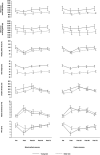Recovery From Eccentric Squat Exercise in Resistance-Trained Young and Master Athletes With Similar Maximum Strength: Combining Cold Water Immersion and Compression
- PMID: 34566669
- PMCID: PMC8461049
- DOI: 10.3389/fphys.2021.665204
Recovery From Eccentric Squat Exercise in Resistance-Trained Young and Master Athletes With Similar Maximum Strength: Combining Cold Water Immersion and Compression
Abstract
The aim of this study was to investigate whether recovery from eccentric squat exercise varies depending on age and to assess whether the use of a mixed-method recovery (MMR) consisting of cold water immersion and compression tights benefits recovery. Sixteen healthy and resistance-trained young (age, 22.1±2.1years; N=8) and master male athletes (age, 52.4±3.5years; N=8), who had a similar half squat 1-repetition maximum relative to body weight, completed two identical squat exercise training sessions, separated by a 2-week washout period. Training sessions were followed by either MMR or passive recovery (PR). Internal training loads [heart rate and blood lactate concentration (BLa)] were recorded during and after squat sessions. Furthermore, maximal voluntary isometric contraction (MVIC) force, countermovement jump (CMJ) height, resting twitch force of the knee extensors, serum concentration of creatine kinase (CK), muscle soreness (MS), and perceived physical performance capability (PPC) were determined before and after training as well as after 24, 48, and 72h of recovery. A three-way mixed ANOVA revealed a significant time effect of the squat protocol on markers of fatigue and recovery (p<0.05; decreased MVIC, CMJ, twitch force, and PPC; increased CK and MS). Age-related differences were found for BLa, MS, and PPC (higher post-exercise fatigue in younger athletes). A significant two-way interaction between recovery strategy and time of measurement was found for MS and PPC (p<0.05; faster recovery after MMR). In three participants (two young and one master athlete), the individual results revealed a consistently positive response to MMR. In conclusion, master athletes neither reach higher fatigue levels nor recover more slowly than the younger athletes. Furthermore, the results indicate that MMR after resistance exercise does not contribute to a faster recovery of physical performance, neuromuscular function, or muscle damage, but promotes recovery of perceptual measures regardless of age.
Keywords: aging; crossover; mixed-method recovery intervention; muscle fatigue; muscle soreness; resistance training.
Copyright © 2021 Schmidt, Ferrauti, Kellmann, Beaudouin, Pfeiffer, Volk, Wambach, Bruder and Wiewelhove.
Conflict of interest statement
The authors declare that the research was conducted in the absence of any commercial or financial relationships that could be construed as a potential conflict of interest.
Figures


Similar articles
-
Assessment of Fatigue and Recovery in Male and Female Athletes After 6 Days of Intensified Strength Training.J Strength Cond Res. 2016 Dec;30(12):3412-3427. doi: 10.1519/JSC.0000000000001427. J Strength Cond Res. 2016. PMID: 27093538
-
Neuromuscular Fatigue and Physiological Responses After Five Dynamic Squat Exercise Protocols.J Strength Cond Res. 2016 Apr;30(4):953-65. doi: 10.1519/JSC.0000000000001181. J Strength Cond Res. 2016. PMID: 26349042
-
The Effects of Eccentric Contraction Duration on Muscle Strength, Power Production, Vertical Jump, and Soreness.J Strength Cond Res. 2017 Mar;31(3):773-786. doi: 10.1519/JSC.0000000000001675. J Strength Cond Res. 2017. PMID: 27787464 Clinical Trial.
-
Effects of cold water immersion after exercise on fatigue recovery and exercise performance--meta analysis.Front Physiol. 2023 Jan 20;14:1006512. doi: 10.3389/fphys.2023.1006512. eCollection 2023. Front Physiol. 2023. PMID: 36744038 Free PMC article.
-
Novel insights into athlete physical recovery concerning lactate metabolism, lactate clearance and fatigue monitoring: A comprehensive review.Front Physiol. 2025 Mar 25;16:1459717. doi: 10.3389/fphys.2025.1459717. eCollection 2025. Front Physiol. 2025. PMID: 40200988 Free PMC article. Review.
References
LinkOut - more resources
Full Text Sources
Research Materials

